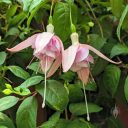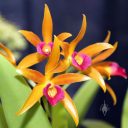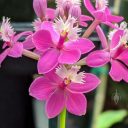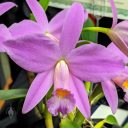





Fuchsias have lots of flower power, and are perennial garden favorites for humans and hummingbirds. They feature charming blooms which dangle like bells in soft pastel colors, or bright reds, pinks, or purples. They’re great companion plants for orchids, too. Our fuchsias, shown in the first two photos above, grow happily in the sun alongside the cool-growing Cymbidiums, Epidendrums, and Dendrobiums that live on our back patio all year.






Fuchsias are native to mountains from South America into Mexico, with a few varieties from New Zealand and South Pacific islands. They need cool summers, high humidity, and regular waterings, which is why they do well in the San Francisco Bay Area, Pacific Northwest, and other locales with mild temperatures and cooling fog. In warmer climates, give these plants more shade, with little or no full sun. In colder climates, they should be brought indoors over winter, or treated as annuals. They’re fairly easy to start from cuttings, making them ideal for sharing with fellow gardeners.
Fuchsia gall mites can be a big problem, causing deformed and stunted leaves and flowers. These pests are difficult to control, but fortunately some varieties are resistant. I find that it’s easier to grow resistant ones than it is to constantly spray insecticides.



Beyond the colorful hybrids grown by most gardeners, there are some fascinating species. The first two photos in the row above show Fuchsia procubens, a marvelous New Zealand native that I’ve kept for many years. Its petite blossoms are bright green, yellow, and red, capped off with blue pollen. The final photo shows another remarkable variety, Fuchsia paniculata, also known as the Fuchsia Tree. When we lived in San Francisco, our garden had a vigorous Fuchsia Tree which was two stories tall. Its clusters of small flowers were much beloved by butterflies, birds, and bees. Both of these species are resistant to mites.















































